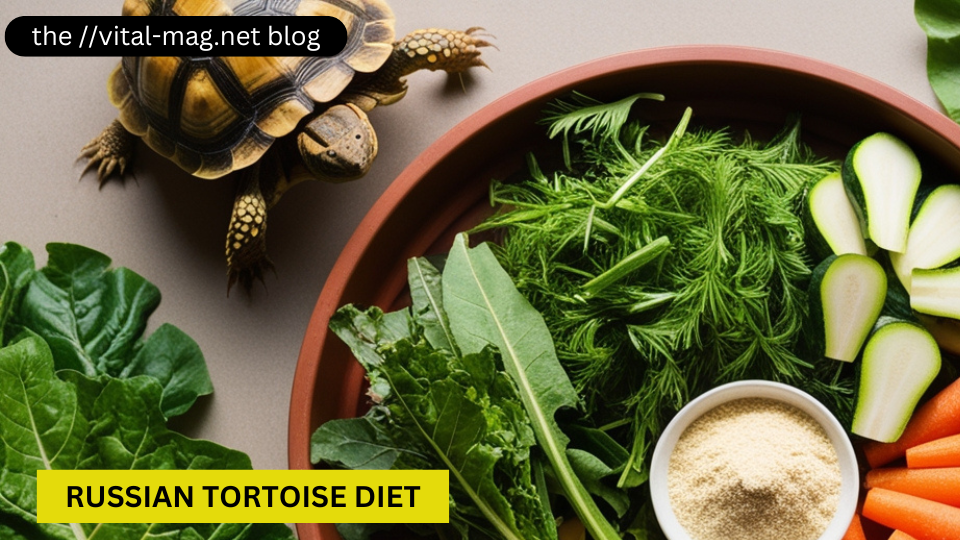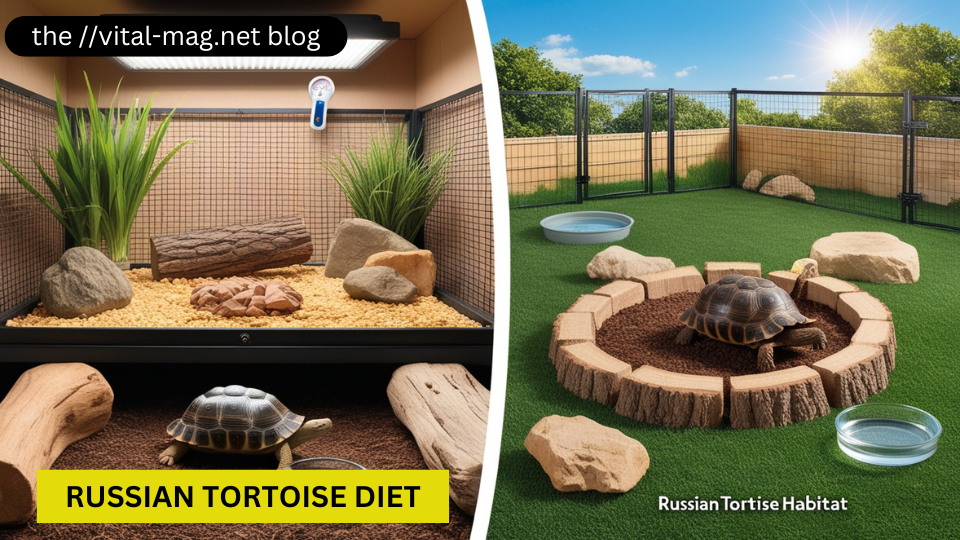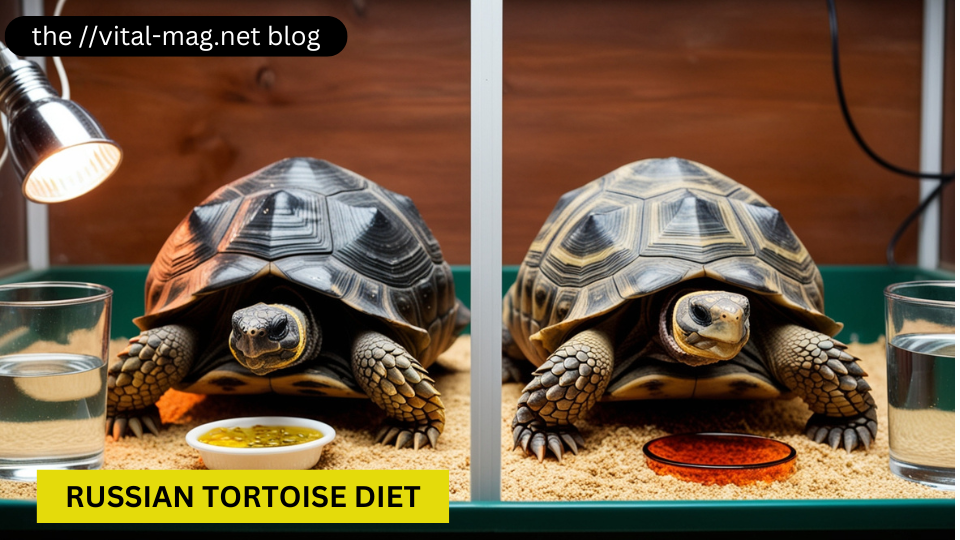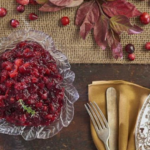Hello to all other tortoise fans! If you are reading this, you are well aware that Russian tortoise diet are wonderful pets. I mean, who would not adore their sweet little faces? But I must warn you that it is not as simple as placing them in a warm corner of our living spaces and letting them be.
It is about making sure that every single one of them is to be their very best all the time. Be it your first tortoise or the fifteenth one, this guide will assist to set not only the right one’s place but also their nutrition as well.
key points
- Leafy Greens as the Mainstay: Russian tortoises thrive on a diet rich in leafy greens. Good options include dandelion greens, collard greens, and mustard greens.
- Vegetables for Nutritional Variety: Include a variety of vegetables like bell peppers, zucchini, and squash. Avoid starchy vegetables like potatoes and corn.
- Occasional Fruits: Fruits should be offered sparingly as treats, with safe options including strawberries, blueberries, and melon.
- High Fiber is Essential: A high-fiber diet aids digestion and helps prevent obesity. Avoid high-protein and high-fat foods that can lead to health issues.
- Calcium Supplementation: Calcium is crucial for healthy shell growth and preventing metabolic bone disease. Offer calcium supplements or cuttlebone regularly.
- Fresh Water Availabilit: Ensure that fresh, clean water is always accessible, as hydration is vital for their overall health.
- Avoid Toxic Plants: Be aware of toxic plants that can harm your tortoise, such as ivy, azaleas, and certain types of ferns. Always research any new plant before introducing it.
- Monitor Health and Behavior: Regularly observe your tortoise for changes in eating habits or health, as these can indicate underlying issues.
Some Essential Facts about Russian tortoise diet
So, what’s the general idea of the Russian tortoises? Let’s break down some basic information into head.

| Characteristic | Details |
| Size | 8-10 inches |
| Lifespan | 40 years or more |
| Natural Habitat | Dry grasslands of Central Asia |
These persons have very famous shells and warm character. The Russian tortoise diet is a very cunning and lively tortoise that enjoys roaming and exploring. But WATS pesters them the most is that no matter how severe the overall climate of the country is, one will always find them.
Ideal Habitat for the Russian Tortoise
Indoor vs. Outdoor Housing
Whether a Russian tortoise diet should be kept indoors or outside is one of the questions I often hear. Both have their advantages; however the merits and demerits must be weighed up.

| Housing Type | Pros | Cons |
| Indoor | Controlled environment, safe from predators | Requires proper lighting (UVB) and temperature regulation |
| Outdoor | Natural sunlight, more space | Needs protection from predators, may be hard to control temperature and humidity |
Indoor Environment is controlled, no threatens from natural wildlife Need effective management of artificial lightings (UVB) and temperatures
Outdoor Sunshine, space There are insurmountable obstacles like animal attacks and extreme weather and sometimes one cannot regulate temperature and humidity
Key Habitat Requirements
Chukwudi: a dedicated environment is crucial to the wellbeing of our tortoises. They are tough creatures but if proper care is not taken especially housing them is hard.
| Requirement | Details |
| Temperature | 75°F to 85°F (cool areas) |
| Basking Spot | 90°F to 95°F |
| Humidity | 30-50% |
| Enclosure Size | At least 4×8 feet for adults |
Both working will depend on your circumstances. I am more for letting my tortigles bask under the warm rays of the outdoor sun but I am always particular about the outdoor enclosures of my tortoises being safe and secure from predators.
Essential Elements of a Russian tortoise Diet
Recommended Foods
Providing a tortoise with enough variety and nutrition is one of the most critical aspects of a tortoise’s husbandry. In nature, Russian tortoises are strictly herbivorous animals feeding on different species of grass or leaves.
Components of diet Main considerations
| Diet Components | Examples |
| Leafy Greens | Dandelion greens, collard greens, mustard greens |
| Vegetables | Carrots, squash, bell peppers |
| Importance of Fiber | Aids digestion and prevents digestive issues |
Importance of Fiber It prevents the body from having stomach complications.
Foods to Avoid for tortoises
You should understand that not all foods are safe for your tortoise. There are some things that you should have given up their eating list, as some can have disastrous results.
| Harmful Foods | Why to Avoid |
| High-protein foods | Can lead to kidney and liver problems |
| Toxic plants | Avoid plants like azaleas, rhododendrons, and buttercups |
The tortoise would do well on a low protein but a high fiber content diet.

Feeding Schedule and Portion Control
Russian tortoises should be fed a particular amount of food at prescribed intervals. This depends on their activity and age but here’s a basic guide to follow:Russian tortoise dietRussian tortoises should be fed a particular amount of food at prescribed intervals. This depends on their activity and age but here’s a basic guide to follow:
| Age Group | Feeding Frequency |
| Adults | Every other day |
| Younger Tortoises | Daily |
No tortoise should therefore go without food for more than two days. For adults, every other day is enough. Younger more growing tortoises should be given food every day. I vary portions of food concentration based on their activity so that they do not become overweight.
Supplements and Hydration
Calcium and vitamin D3 supplementation is essential.
The skeleton cannot be formed properly without calcium D3, with the latter being most important, but, without addressing dietary balance, it is a supplement that is sometimes necessary. I make sure the environment they are being held in does not restrict them from obtaining enough calcium and D3.
| Supplement | Importance |
| Calcium | Crucial for shell and bone health |
| Vitamin D3 | Helps with calcium absorption |
Hydration Tips
And of course, always provide fresh water! It is likely that even the Russian tortoise although it comes from hot and dry climates should still have water to drink. Soaking tortoises in shallow dishes is also what I do in order to keep their hydration level maintained.Russian tortoise diet.
Smooth Russian Tortoise: Given the Indicators
Behavioral and Physical Health Indicators
How do you know there is a healthy tortoise? This is its key information:
| Health Indicators | What to Look For |
| Behavioral Cues | Active, curious, responsive |
| Physical Appearance | Bright, clear eyes; clean, smooth shell; steady weight |
I am always on the lookout for such signs so as to maintain the health of my tortoises. You should always seek a vet’s opinion if you have any unusual situations.
Russian tortoises common problems
Respiratory Infections
Health problems sometimes occur even in very good care. Respiratory infections are a typical infection that must be taken seriously as if not managed well, it brings about great medical issues.
| Health Problem | Symptoms |
| Respiratory Infections | Wheezing, nasal discharge |
Health Problem Symptoms
Respiratory Infections Wheezing, nasal discharge
Shell Problems
Shell troubles are not exceptions though, often appearing when your tortoise is lacking proper nutrition or is in poor maintenance.
Health Problem Symptoms
Shell Problems Soft, avascular areas, discoloration, defects
If your observation is along these lines, seeking a veterinarian quick response could be beneficial. To avoid a progression of diseases, it is essential to stay current with check-ups as well as adopt a preventive health approach.
Tortoise Care in Veterinary World
Prevention
It is important for your tortoise’s wellbeing to organize visits to a veterinarian from time to time. Here’s what you can expect:
| Vet Visit Expectations | Details |
| Check-ups | Shell condition, weight, overall health |
| Vaccinations | Discuss preventive care with your vet |
There are no problems that concern tortoises’ owners: the relations between pet and a trusted vet can has a long lasting tone of care and protection.
Enrichment and Socialization
Environmental Enrichment Ideas
Providing mental stimulation is just as important as offering a balanced diet. Here are some ways to enrich your tortoise’s life:
| Enrichment Activity | Examples |
| Environmental Enrichment | Add rocks, logs, and different textures to their enclosure |
Safe Social Interaction Tips
Let your tortoise roam and explore under supervision. It’s a great way to bond and keep their minds active. Just make sure they’re safe from potential dangers like predators or harsh environmental conditions.
Breeding Russian Tortoises
Breeding Requirements
Thinking about breeding your tortoises? Breeding Russian tortoise diet can be a rewarding but challenging endeavor. Here are a few things to consider:
| Breeding Requirements | Considerations |
| Space | Provide enough room and stable temperatures for egg-laying |
Hatchling Care
Hatchlings require special care and attention, so be prepared for a long-term commitment.
| Hatchling Care | Details |
| Diet | High-calcium diet, frequent feedings |
Common Misconceptions About Russian Tortoises
Myths vs. Reality
There’s a lot of misinformation out there about Russian tortoise diet. Let’s debunk a few myths:
| Myth | Reality |
| Short Lifespan | Russian tortoises can live over 40 years with proper care |
| Dietary Myths | Not all vegetables and fruits are safe for tortoises—stick to the basics! |
It’s important to stay informed and always do your research to provide the best care possible for your tortoise.
Resources for Russian Tortoise Owners
Books and Websites
There’s always something new to learn! Here are some resources that have been incredibly helpful in my tortoise care journey:
| Resource Type | Examples |
| Books and Websites | Expert guides from herpetologists |
Online Forums
Connect with other tortoise enthusiasts for tips and advice. Staying connected with the tortoise community is a great way to share knowledge and ensure your tortoise gets the best care possible.
Also Read Our Article On Nutrition And Died: Body Recomposition Diet – Losing Weight And Adding Muscle Mass
FAQs
What is the Best Diet for a Russian Tortoise?
A balanced diet should primarily consist of leafy greens, vegetables, and occasional fruits. Avoid high-protein foods and toxic plants.
How Often Should I Feed My Russian Tortoise?
Feed adult tortoises every other day, while younger ones require daily feedings.
What Temperature Should a Russian Tortoise Habitat Be?
Maintain a cool area between 75°F to 85°F and a basking spot around 90°F to 95°F.
Conclusion
Caring for a Russian tortoise diet is such a rewarding journey filled with learning and love. Proper care, a balanced diet, and a stimulating environment are essential for their health and happiness. Let’s keep exploring their needs and stay connected with other tortoise enthusiasts. Your little shelled friend is counting on you!






